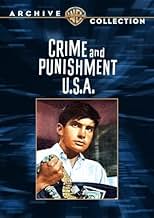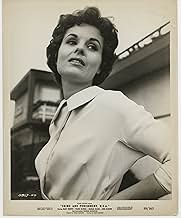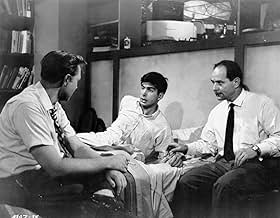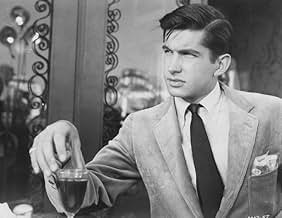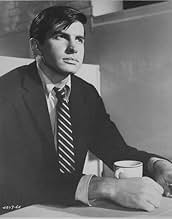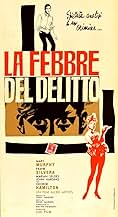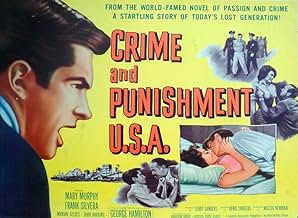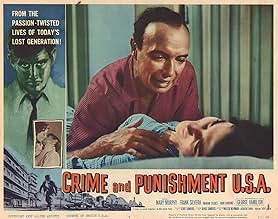Ajouter une intrigue dans votre langueA Californian law student murders a pawnbroker, then matches wits with the detective on the case.A Californian law student murders a pawnbroker, then matches wits with the detective on the case.A Californian law student murders a pawnbroker, then matches wits with the detective on the case.
- Director
- Writers
- Stars
- Nominé pour le prix 1 BAFTA Award
- 2 victoires et 1 nomination au total
Tony Johnson
- Mrs. Cole
- (as Toni Merrill)
Sidney Clute
- Doctor
- (as Sid Clute)
James Hyland
- Man in Coffee Shop
- (as Jim Hyland)
Avis en vedette
I haven't seen this movie for more years than I care to remember. It was released accompanied by sensationalistic contemporary tag lines -- "Beatniks! Rebels!" -- partly because George Hamilton is seen playing the bongos once in a while. Yet, it has stuck in my memory. It really was an unusual film.
First of all, Dostoyevsky is rather awkwardly superimposed on a story involving residents of modern L.A. The novel doesn't quite fit on the setting. People have serious conversations about God and the afterlife. Okay for a 19th-cntury Rusian novel -- but sunny California? Home of the Fountain of the World Cult?
And it always bothered me about the novel that everyone in Petersberg seems to be acquainted with everyone else. It was a bit difficult to swallow that proposition in the novel; it is absolutely impossible for that to have been true in L.A. circa 1960, the most anomic community on the face of the planet. But instead of being an irritation, the lack of fit between the plot and its contemporary setting lends the film an unquiet, almost surreal quality. Something is off kilter and we don't know exactly what. We squirm with bemusement.
Two points ought to be made. The movie must have been shot on the cheap. In this case, it inadvertently helps. We are given a tour of the seedier sections of L.A. -- railroad tracks, refuse dumps, shabby housing -- that a better-funded film would probably have avoided. Instead of Echo Park we get a slum. This is commonplace now, but it wasn't at the time. It's too bad nobody in California seems to know what a genuine slum looks like. Here it's all a sun-drenched, palm-fronded, flower-strewn paradise, however desecrated. They should have set it in Newark. And they needn't have used high-key lighting so consistently. It looks like an early television sitcom.
Second, the acting is actually quite good. I am even willing to forgive George Hamilton's handsomeness. (He's always been willing to poke fun at himself anyway.) Mary Murphy is not the young naif she played in "The Wild One." She's not exactly a hooker either, as she was in the novel. In 1960 neither audiences nor agents of social control were prepared for that. But she is a serious kind of easy lay, which was still saying a lot. Best of all is Frank Silvera. The smooth admirable way in which he insinuates himself into Robert's life. The cat and mouse repartee. The wondering expression on his face, his amazement that Hamilton has not yet caught on, as he tells him who committed the murder -- "Why YOU did, Robert."
I don't know how I would respond to the movie now, lo, these many years later. But, crude as it is, it's not just a shoddy ripoff of a famous psychological drama. It would be a mistake to think so. If all the elements of the film are amateurish, as in a high school play, the people involved seem to be hitting the right notes by accident. This is worth catching, a real curiosity.
First of all, Dostoyevsky is rather awkwardly superimposed on a story involving residents of modern L.A. The novel doesn't quite fit on the setting. People have serious conversations about God and the afterlife. Okay for a 19th-cntury Rusian novel -- but sunny California? Home of the Fountain of the World Cult?
And it always bothered me about the novel that everyone in Petersberg seems to be acquainted with everyone else. It was a bit difficult to swallow that proposition in the novel; it is absolutely impossible for that to have been true in L.A. circa 1960, the most anomic community on the face of the planet. But instead of being an irritation, the lack of fit between the plot and its contemporary setting lends the film an unquiet, almost surreal quality. Something is off kilter and we don't know exactly what. We squirm with bemusement.
Two points ought to be made. The movie must have been shot on the cheap. In this case, it inadvertently helps. We are given a tour of the seedier sections of L.A. -- railroad tracks, refuse dumps, shabby housing -- that a better-funded film would probably have avoided. Instead of Echo Park we get a slum. This is commonplace now, but it wasn't at the time. It's too bad nobody in California seems to know what a genuine slum looks like. Here it's all a sun-drenched, palm-fronded, flower-strewn paradise, however desecrated. They should have set it in Newark. And they needn't have used high-key lighting so consistently. It looks like an early television sitcom.
Second, the acting is actually quite good. I am even willing to forgive George Hamilton's handsomeness. (He's always been willing to poke fun at himself anyway.) Mary Murphy is not the young naif she played in "The Wild One." She's not exactly a hooker either, as she was in the novel. In 1960 neither audiences nor agents of social control were prepared for that. But she is a serious kind of easy lay, which was still saying a lot. Best of all is Frank Silvera. The smooth admirable way in which he insinuates himself into Robert's life. The cat and mouse repartee. The wondering expression on his face, his amazement that Hamilton has not yet caught on, as he tells him who committed the murder -- "Why YOU did, Robert."
I don't know how I would respond to the movie now, lo, these many years later. But, crude as it is, it's not just a shoddy ripoff of a famous psychological drama. It would be a mistake to think so. If all the elements of the film are amateurish, as in a high school play, the people involved seem to be hitting the right notes by accident. This is worth catching, a real curiosity.
This is a well written script based on Dostoyevsky's "Crime and Punishment." I think it is essentially a remake of a French film, with Jean Gabin,called "Crime and Punishment," later changed to "The Most Dangerous Sin," made around the same time. At any rate, self- justification, remorse, rationalization, guilt, and Truth are the subjects at hand. Each is handled slowly, without emphasis; the viewer is expected to bring much to the picture. This explains the films lower ratings. Hamilton, as an actor, is weak, others have been reminded of Tony Perkins. He was too handsome, and wasn't smart enough to use make up or a cheap haircut to make himself appear to be the poor student of his role. But, the real star is Frank Silvera, who underplays the cagey Detective, and is a joy to watch in action. He toys with Hamilton, who, unfortunately, just isn't his match (as an actor.) Marian Seldes plays Hamilton's long suffering sister.
Actually more like the previous years' COMPULSION than a modernization of Fyodor Dostoevsky's CRIME AND PUNISHMENT... although that's exactly what it is, by title, and if Frank Silvera's friendly, complimenting homicide detective is reminiscent of the 1970's TV-cop COLUMBO, both are based on the same literary character...
And ironically, George Hamilton became a victim-of-persuasion from both determined constables and here, resembling Anthony Perkins with the combined personalities of either COMPULSION killer... broodingly into Atheist philosophy while acting too good for everyone, in particular the earthy lawman... he's more aimless than guilt-ridden...
The grainy-B&W Los Angeles-set sequences between Hamilton's Robert and the affable yet clinging detective are no different in tone than existential conversations with deep-thinking heart-of-gold-hooker Mary Murphy, his best buddy (Wayne Heffney) or his sister's middle-aged fiance (seeming straight from an Actor's Studio workshop)... yet the overall stagey aspect's so upfront and natural, CRIME feels more intriguing than meandering...
And while never claiming to be a thriller, it's no melodrama either, fitting within a kind of Beatnik's soulless journey that... between the genuine street thug film noirs and the colorful counter-culture neo noirs... exists within the sharpened jazz-soaked cinema of the late 1950's, as unappreciated now as it was back then.
And ironically, George Hamilton became a victim-of-persuasion from both determined constables and here, resembling Anthony Perkins with the combined personalities of either COMPULSION killer... broodingly into Atheist philosophy while acting too good for everyone, in particular the earthy lawman... he's more aimless than guilt-ridden...
The grainy-B&W Los Angeles-set sequences between Hamilton's Robert and the affable yet clinging detective are no different in tone than existential conversations with deep-thinking heart-of-gold-hooker Mary Murphy, his best buddy (Wayne Heffney) or his sister's middle-aged fiance (seeming straight from an Actor's Studio workshop)... yet the overall stagey aspect's so upfront and natural, CRIME feels more intriguing than meandering...
And while never claiming to be a thriller, it's no melodrama either, fitting within a kind of Beatnik's soulless journey that... between the genuine street thug film noirs and the colorful counter-culture neo noirs... exists within the sharpened jazz-soaked cinema of the late 1950's, as unappreciated now as it was back then.
In California, Robert Cole (George Hamilton) collapses in front of the cops. He buries the evidence of his crime, but a dying man may have seen him. He takes the man back home to Sally. He had written an article stating that certain superior people can break the law which comes to the notice of the police. He is brought in for an interview.
This opens on Pacific Ocean Park in Santa Monica. The most fascinating part of this B-crime movie may be the locations. It's great to see the old California with all the oil rigs. It does have a young George Hamilton as the lead. He's fine, but he's never been a great actor. I wanted this to start as a darker noir crime thriller. Robert should leave the man to die on the side of the road. That's the darker start. It's interesting that Robert has his views. Otherwise, the plot drags and I don't really care about him. This is not as compelling as it should be.
This opens on Pacific Ocean Park in Santa Monica. The most fascinating part of this B-crime movie may be the locations. It's great to see the old California with all the oil rigs. It does have a young George Hamilton as the lead. He's fine, but he's never been a great actor. I wanted this to start as a darker noir crime thriller. Robert should leave the man to die on the side of the road. That's the darker start. It's interesting that Robert has his views. Otherwise, the plot drags and I don't really care about him. This is not as compelling as it should be.
A young man murders an old woman for money, then relies on a sense of intellectual superiority to defeat an investigating detective.
A heavyweight subject like Dostoevski would be a challenge for the most experienced filmmaker. For the youthful crew here, however, it proves way too much. For one, Hamilton simply doesn't have the gravitas to bring off a convincing intellectual heavyweight, and that punches a hole right through the film's middle. But he's not the only one. Silvera's cagey detective makes those cat and mouse sessions with Robert (Hamilton) borderline parody. I don't know what director Sanders was telling him, but whatever it was, it didn't work. Ditto Harding's hammy wife killer that produces another regrettable result. Unfortunately, acting here means more than usual since there's so much loaded conversation. Only the two women, Murphy and Seldes, come off aptly.
On the other hand, the filmmakers certainly don't lack imagination. Adapting a bleak 19th- century Russian novel to the sunny climes of LA amounts to an imaginative undertaking, whatever the outcome. However, modifying a dense 1,000-page novel into a 70-minute screenplay would be a challenge for Dostoevski himself. Unfortunately, the effort here is like trying to pack 10 lbs. of weighty story into a 5 lb. leaky screenplay. All in all, I'm glad the Sanders brothers and Hamilton went on to more appropriate projects.
A heavyweight subject like Dostoevski would be a challenge for the most experienced filmmaker. For the youthful crew here, however, it proves way too much. For one, Hamilton simply doesn't have the gravitas to bring off a convincing intellectual heavyweight, and that punches a hole right through the film's middle. But he's not the only one. Silvera's cagey detective makes those cat and mouse sessions with Robert (Hamilton) borderline parody. I don't know what director Sanders was telling him, but whatever it was, it didn't work. Ditto Harding's hammy wife killer that produces another regrettable result. Unfortunately, acting here means more than usual since there's so much loaded conversation. Only the two women, Murphy and Seldes, come off aptly.
On the other hand, the filmmakers certainly don't lack imagination. Adapting a bleak 19th- century Russian novel to the sunny climes of LA amounts to an imaginative undertaking, whatever the outcome. However, modifying a dense 1,000-page novel into a 70-minute screenplay would be a challenge for Dostoevski himself. Unfortunately, the effort here is like trying to pack 10 lbs. of weighty story into a 5 lb. leaky screenplay. All in all, I'm glad the Sanders brothers and Hamilton went on to more appropriate projects.
Le saviez-vous
- AnecdotesThe opening aerial shots are of Pacific Ocean Park in Santa Monica, CA, a popular amusement park in the 1960s that has since closed down.
- ConnexionsReferenced in Hollywood Mouth 3 (2018)
Meilleurs choix
Connectez-vous pour évaluer et surveiller les recommandations personnalisées
Détails
- Durée1 heure 36 minutes
- Couleur
- Mixage
Contribuer à cette page
Suggérer une modification ou ajouter du contenu manquant

Lacune principale
By what name was Crime & Punishment, USA (1959) officially released in India in English?
Répondre
